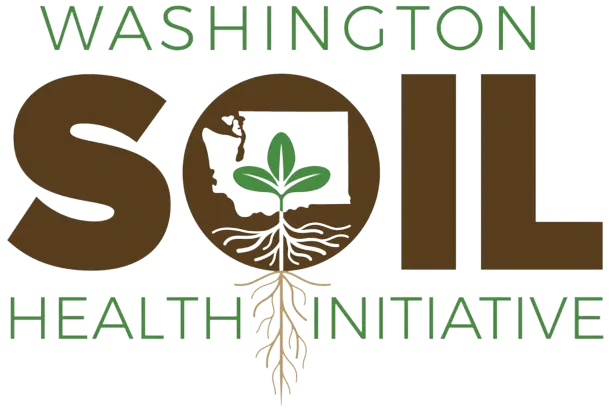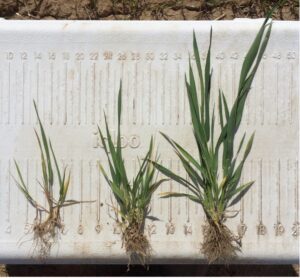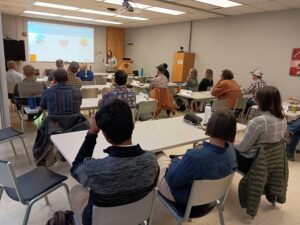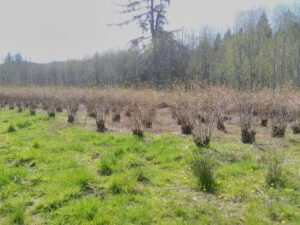
© Palouse Conservation District
New precision agriculture technologies explained through Sustainable Farms and Fields Program
Tackling soil acidification, nitrogen deficiencies, and precision drone use in dryland regions in a recent field day
September 4, 2024
Author: Lauren Kirkpatrick
On June 27th, Palouse Conservation District and partners, Washington State University and USDA Northwest Sustainable Agroecosystems Research program were lucky enough to host local farmers and discuss new precision agriculture technologies with funding from the Washington State Conservation Commission’s Sustainable Farms and Fields Program, Western SARE, USDA-NRCS, National Association of Conservation Districts, and the Climate Commitment Act. The primary topics of the day were the use of drones for fertilizer/herbicide application and mapping, sap analysis as a diagnostic tool, precision application of lime to combat rising pH levels, and finally, nitrogen loss through tile drainage.
Drone application of herbicide and fertilizer—Altitude Agri Services

PRECISION AG FROM THE AIR | Kurt Beckley from Altitude Agri Services to the group at the Sustainable Farms and Fields field day.
© Palouse Conservation District
Drones have recently taken the agriculture world by storm. This new technology provides an innovative approach to sustainable farming through its ability to customize its applications to the crop and its landowners’ preferences. From mapping and monitoring to moisture abatement (where an excess of water causes fruit cracking and mildew) and the most popular service, spraying and seeding, drones prove to be a one-stop-shop for precision agriculture.
When using drones for spraying applications, the process begins by mapping the field and using plant-identifying technology to create a map of the targeted weed’s location. This map is then uploaded into the drone, and they are guided out to their designated spots. While this process may sound familiar to other products out there, the use of drones provides additional benefits like:
- Reduction of costs in terms of gas, herbicide/fertilizer/and labor
- Reduced soil compaction
- Reduced trampling of crops —“Research in wheat shows that crop trampling while spraying can result in up to a four percent yield loss if spraying is delayed.” (Top Crop Manager, 2007).
For more information, see these articles:
Plant Sap Analysis as a Diagnostic Tool—Apical Crop Science, David Knaus
The use of plant sap to analyze crop and plant health is no new concept; in fact, its origin dates back to the 1930s ( History of Plant Sap Analysis). Since then, it has continued to develop and grow through advancements in technology and research, proving to be a valuable tool for farmers across the board.
But let’s start at the beginning: What is plant sap analysis, and how does it fit in the precision agricultural world?
Apical Crop Science, a company leading the charge in the sap analysis world, retains a mission of using “modern analytical methods, eco-friendly growing products and smart data management techniques to provide growers with the tools they need to grow extremely healthy, optimal-yielding crops, organically and with minimal pest problems.”
In order to achieve this, Apical uses two approaches, leaf tissue analysis and leaf extract analysis. While similar in name, the two different practices use different components of the plant for testing. In plant tissue analysis, the plant cellular tissue is used for testing while, the leaf extract analysis uses cellular fluids for testing.
Both methods provide feedback that will speak to the crop’s overall health, however when using the leaf extract analysis, more data is able to be extracted because the plant fluids are measured before becoming part of the leaf tissue, providing even more information on crop health.
The information that can be gleaned from this process includes:
- Crop nutrient profile
- Fertilization optimization—by identifying macro- and micro-nutrient deficiencies
- Toxic elements within the plant causing it stress
- Sugar levels
- Total Sugars (TS) is a general indicator of plant health and vigor.
- Higher TS is usually indicative of good Calcium uptake and crops with desirable qualities (health, yield, flavor, shelf life, etc.).
- Generally, as TS increases, insect and disease pressure decrease
- pH levels
- Lower pH readings usually indicate low levels of light, low microbial activity, a low concentration of cations, an excess of anions, or too much water.
- High pH often indicates excessive heat, an excess of cations, low total anions, or insufficient water.
For more information on report parameters, please visit - How to Read Reports - Apical Crop Science (apical-ag-home.com)
Precision application of lime to combat rising soil pH—Dr. Dave Huggins and Carol McFarland, Washington State University

AN EMERGING THREAT | Dr. Dave Huggins addressing the crowd about soil acidification while out in the field at Cook Agronomy Farm.
© Palouse Conservation District
A growing concern here in Eastern Washington is soil acidification. Here at the Palouse Conservation District, our Research & Monitoring team has been taking pH measurements of fields throughout the Palouse region and have found levels to be in the range of 4.8 to 8.0. The implications of this issue and some proposed solutions were discussed by Dr. Dave Huggins of USDA-ARS and Carol McFarland of WSU on the Sustainable Farms and Fields demonstration day.
The conversation began by first speaking about what causes acidification within agricultural fields. Soil can acidify on its own through natural processes. However, this process can be accelerated by the application of nitrogen-based fertilizers. As this fertilizer breaks down, lone positive H ions are left within the soil and can inhibit the plant from up taking the nutrients it needs for optimal growth.
To correct this, Carol McFarland and Dr. Dave Huggins recommend the following:
- Leaving crop residue in the field to help increase organic matter content
- Use crop rotations and incorporate legumes
- Use alternative nitrogen fertilizers – try to avoid ammonia-based fertilizers
- Apply Lime
Read more about soil acidification
If interested in applying lime, the team at the Cook Agronomy farm built a precision lime application machine that helps target the soil levels where soil acidification often takes place. In addition to this, the team at Small Grains WSU Extension developed a Agricultural Liming Material Selection and Comparison Calculator, in effort to help landowners identify how much lime they need to apply to their soil.
Nitrogen loss through tile drainage—Dr. Erin Brooks, University of Idaho
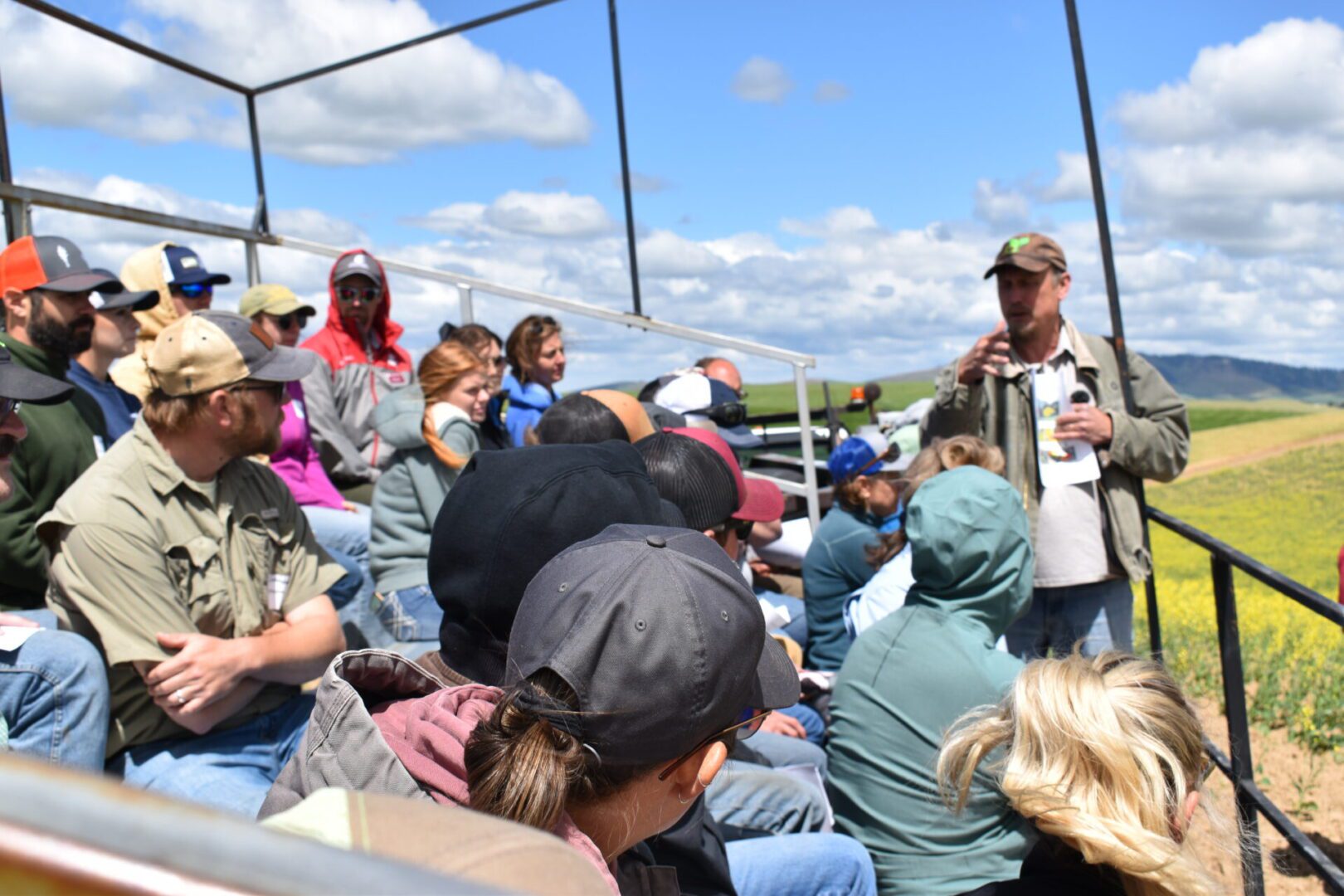
ADAPTING TO CHANGING PRECIPITATION | Dr. Erin Brooks speaking about the results of a trial looking at nitrogen loss.
© Palouse Conservation District
There have been many changes that impact farming, but none more so than climate change. With changing climatic elements, such as shifts in seasons, more rain, and less snowpack, farmers must learn how to adjust their farms’ natural processes to achieve success.
This is where Dr. Erin Brooks and a team of individuals at the University of Idaho come in. Using the property at Cook Agronomy Farm, this team looked at two different fields: a business as usual, with reduced tillage practices, and a study plot with no-tillage practices.
Within these plots, subsurface drainage (Parshall Flume) and surface runoff (Heated H-flume) are measured, along with precipitation and CO2 fluxes with Eddy Covariance Towers.
Data was collected from November 2023 – June 2024 and presently reflects that the business-as-usual catchment has:
- Greater infiltration
- Reduced runoff
- Increased subsurface drainage
- Greater retention of soil moisture
So, what does this all mean for nitrogen within the soil? Well, if we look at the business-as-usual soil characteristics above, we can deduce that nitrogen losses will be greater in this scenario.
Due to the soil’s higher infiltration capabilities and higher moisture retention, nitrogen seeps into the soil more easily. However, it was also observed that there was increased subsurface drainage, which means that this stored nitrogen is being lost here.
Finally, excess amounts of nitrogen were found within the study plot’s surface runoff water samples. These findings prove to be helpful for future research about the benefits of no-till or reduced till and how landowners can better plan their nitrogen budget for optimal crop growth.
For more publications by Dr. Erin Brooks please visit - Erin Brooks - Soil and Water Systems | University of Idaho (uidaho.edu)
Read about more Sustainable Farms and Fields Program Projects

Lauren Kirkpatrick
Lauren graduated from Washington State University with her bachelors and master's in environmental science. Afterwards she began working with the Palouse Conservation District where she gets to combine her two passions of working with the public in local conservation and sustainable agricultural practices.
This article was published by the Washington Soil Health Initiative. For more information, visit wasoilhealth.org. To have these posts delivered straight to your inbox, subscribe to the WaSHI newsletter. To find a soil science technical service provider, visit the Washington State University Extension website or the Washington State Conservation District website.

